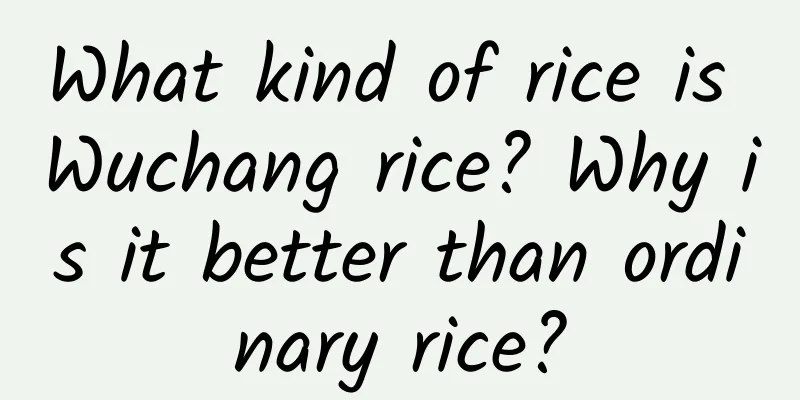What kind of rice is Wuchang rice? Why is it better than ordinary rice?

|
Recently, a professional counterfeiter questioned the authenticity of the Wuchang rice sold by a live broadcaster. In fact, the controversy over the authenticity of "Wuchang Rice" has been a hot topic of concern in recent years and often appears on hot searches. The reason is that Wuchang rice is really delicious, but the output is indeed not high, and "fakes" appear from time to time. What kind of rice is Wuchang rice? Before talking about Wuchang rice, let's talk about Wuchang City. Wuchang City is adjacent to Harbin City in Heilongjiang Province. It is named after the "Wuchang" of benevolence, justice, courtesy, wisdom and trustworthiness. Wuchang City has a well-developed water system and a dense network of rivers. The soil in many areas is fertile, which is very suitable for growing rice. However, it is not easy to grow rice in Heilongjiang. As we all know, the climate in Heilongjiang is relatively cold. Compared with Hainan, where rice can be grown four seasons a year, places like Wuchang in Heilongjiang can only grow rice once a year, and the growing period is very long. Seedling cultivation requires the help of greenhouses or greenhouses. Copyright images in the gallery. Reprinting and using them may lead to copyright disputes. Moreover, the temperature difference between day and night in Wuchang during the rice harvest period is large. These factors make the rice in Wuchang have high dry matter content, moderate amylose, and high amylopectin content. In layman's terms, the rice produced here is large and full, chewy, with high oil content and rich aroma. To sum it up, it can be summed up in two words - delicious. So, is the rice produced in Wuchang called Wuchang rice? Is it one kind of rice or several kinds of rice? Broadly speaking, as long as the seeds are from the Wuyoudao series, Songjing series and other japonica rice varieties that meet the planting conditions of Wuchang, and comply with the rice implementation standard GB/T19266 (which is the implementation standard of Wuchang rice), and are planted in the Wuchang area, it can be called "Wuchang rice". Information about a Wuchang rice product taken by the author However, in the eyes of ordinary consumers, the most representative rice in Wuchang is Wuyou Rice No. 4 in the Wuyou Rice series, which is commonly known as Daohuaxiang No. 2. This variety is the rice variety with the largest planting area in Wuchang City. When we consumers usually refer to Wuchang rice, we are referring to the rice processed from Daohuaxiang No. 2 planted in Wuchang City, which tastes quite authentic! It should be pointed out that to make good rice, you first need good varieties, and secondly, a suitable environment. Even if the variety is right, the flavor will be much worse if it is grown in an area with a different climate. If you play word games and skirt the rules under the banner of Wuchang rice, but the product you sell is not what you claim it is, don't blame others for questioning and criticizing you. The breeding story behind Wuchang rice Behind every excellent variety there is often a legend of the breeder, and this is also true for Daohuaxiang No. 2. Tian Yongtai, the first breeder of Daohuaxiang No. 2, is of Korean ethnicity. In the 1950s, Tian Yongtai came to Wuchang City, Heilongjiang Province from Cheongsan South Province, South Korea. In 1966, he became the May Day production team leader of Longfengshan Township. The local rivers and water resources are relatively abundant, so rice can be grown. However, there were no suitable rice varieties in the local area at that time, and most of the introduced varieties came from Liaoning next door. Although they are both in the northeast and so close, the introduced rice immediately showed problems of acclimatization, and the yield was also very low, less than 200 kilograms per mu. Especially in 1969, the temperature dropped rapidly before the rice planted that year had matured, causing more than 150 hectares of rice in Tian Yongtai's production brigade to be severely affected, and the entire production brigade was even facing a total crop failure and hunger. Growing good rice is never easy. Photo by the author At the suggestion of an old farmer in the village, Tian Yongtai began to look for early-maturing rice ears in the fields. He searched for six days in a row but failed to find the early-maturing rice ears he wanted. At noon on the seventh day, when he was about to give up in despair on the ridge of the field, he inadvertently saw a cluster of golden rice ears bending and swaying in the wind not far away. He hurriedly took the 12 mature rice ears home and hung them on the window of the production team for preservation, but after a wind blew, only 7 ears were left. He then numbered the seeds from 1 to 7 according to the rice ears. After a year of planting, the offspring of the No. 7 ear met the demand for early maturity. He also harvested 48 kilograms of seeds from the No. 7 ear. After another year, the 48 kilograms of seeds turned into 5,000 kilograms of rice. Tian Yongtai named this seed "517". This rice is not only suitable for local farming, but also very delicious. Local people have widely planted it for more than ten years. Later, Tian Yongtai was transferred to the university as vice president. Once when he returned to Longfeng Mountain for work, the old man in the village anxiously said to Tian Yongtai, "Old Tian, come back soon, the '517' is gone." It turned out that after years of planting and the ravages of rice blast, the delicious "517" that was originally bred gradually disappeared. Tian Yongtai always kept in mind the old farmer's expectations for him. In 1993, on the same plot where "517" was discovered, Tian Yongtai accidentally discovered a rice plant with 12 ears of long grains, awns, and rings, which was different from the rice in the north at that time. Not only did this rice plant look different from the common northern rice, but the steamed rice after planting it had a fragrant aroma. After breeding, it was named "93-8". After continuous cultivation and selection, "93-8" performed very well in taste, aroma, disease resistance, and yield, and was named "Wuyou Rice No. 1". After that, the Wuyou Rice series has been continuously improved, and in 1999, Wuyou Rice No. 4, also known as Daohuaxiang No. 2, was launched. This is also the origin of Wuchang rice, which is the most widely planted rice today. In 2021, Tian Yongtai passed away at the age of 82. He had lived through war and hunger, but he never forgot to fill everyone's stomach. He not only thought about having enough to eat, but also thought about eating well for the people. He was praised by the people of Wuchang as the "Father of Rice Flower Fragrance" and the "Yuan Longping" of Northeast China. ****Modern breeding has achieved directional selection and improvement With modern breeding technology, the speed and efficiency of breeding have been greatly improved. Compared with the previous luck, it is now possible to achieve targeted breeding and targeted improvement. With the completion of the sequencing of the rice genome, we have learned about the entire genome of rice, which is undoubtedly exciting for breeders. Now we can verify the function of each gene through experiments based on genome information and the differences between different rice varieties, and then use molecular biology technology to improve a certain trait of a certain variety. Through rapid generation technology such as plant breeding factories or southern propagation, the breeding cycle will be greatly shortened. Although modern rice breeding has developed rapidly relying on modern biotechnology and cultivation systems, it is by no means an easy task. First of all, as the saying goes, a good cook cannot cook without rice. If you want to cultivate good rice, you must have relatively rich rice germplasm resources. Only with a large amount of germplasm resources can you have room for operation and cultivate excellent varieties. In addition, even though modern breeding technology has improved a lot compared to the past, breeding is still a difficult task. For example, rice breeding generally requires hybridization, and the most commonly used operation in hybridization is manual emasculation. Since rice has hermaphroditic flowers and the flowers are particularly small, it is necessary not only to grasp the right time when emasculating, but also to emasculate cleanly without damaging the pistil. After cutting off the lemma one by one, the pollen of the male plant is shaken onto the inflorescence of the emasculated female plant. After pollination, fertilization and development, seeds are formed and hybrids are obtained. Then, molecular detection technology is used to screen out "true hybrids." Manual pruning and removal of tassels, pay attention to the size and number of flowers. Photo by the author The true hybrids are then hybridized with the excellent parents, and the individuals containing the target gene are selected through molecular testing and hybridized with the excellent parents again. Multiple rounds of experiments are necessary to obtain individuals that carry the target gene and are infinitely close to the excellent parents, thus achieving the purpose of improvement. Note that the clumps in the distance that are taller than the others need to be screened out. Photo by the author The approval of new varieties needs to go through the steps of variety application, variety experiment, approval, and announcement. The applied varieties must have specificity, consistency, and stability. Variety experiments include one year of preparatory experiments, two years of regional experiments, and one year of production experiments. The whole process is coded testing, and the names of experimental materials and breeding units are not disclosed. Only after strict review by the expert group can it pass the variety experiment stage. In the approval stage, the variety parameters must be checked to see if they meet the requirements. If they meet the requirements, they must be announced before the variety approval can be completed. Therefore, it takes at least four to five years, and at most 20 to 30 years, or even several generations of hard work, for a variety to become a new variety from the beginning of breeding. Therefore, breeders generally do not mail or consign important breeding materials, but carry them with them on their backs. Although old breeders such as Yuan Longping and Tian Yongtai have passed away quietly, generations of breeders who follow the old breeders are still working silently. After all, agriculture is the foundation of a country, and seed industry is the core of agriculture. We often say that Chinese people must hold their own rice bowls, and having far-leading varieties is the key to holding the rice bowl well and firmly. Planning and production This article is a work of Science Popularization China-Starry Sky Project Produced by: Science Popularization Department of China Association for Science and Technology Producer|China Science and Technology Press Co., Ltd., Beijing Zhongke Xinghe Culture Media Co., Ltd. Author: Miaobishenghua, a graduate student in agronomy and seed industry Review丨Cheng Xuzhen, Researcher, Institute of Crop Sciences, Chinese Academy of Agricultural Sciences Planning丨Ding Zong Editor: Ding Zong |
>>: Only 1 second deviation in 7.2 billion years! Chinese scientists achieve breakthrough
Recommend
The new version of the APP is launched. Have you done these operations?
The APP has just been launched, so naturally ther...
Baidu announces pure vision L4 autonomous driving solution "Apollo Lite"
At CVPR (the world's top academic conference ...
Understand the HAL hardware abstraction layer in the Android system architecture
Introduction to HAL HAL refers to the Hardware Ab...
How to plan a marketing campaign that reaches 1 million people
When I first learned about the event, I actually ...
Jawbone up3 bracelet experience: playing is bigger
For most consumers, cost-effectiveness is the pri...
Content Marketing Trends in 2017 (Part 2)
Preface: The 2017 Content Marketing Trends (Part ...
What will happen to the Qinghai-Tibet Plateau if global warming rises by 2°C?
If the global temperature rises by 2°C, what will...
Double 11 Sale: Are Things Really Cheaper?
Yesterday, the Beijing Industry and Commerce Bure...
These outrageous express deliveries received on Double Eleven are so ridiculous that I can’t even saw them open with a knife
Have the "good things" you bought on Do...
Movie Hurricane reveals the dark side of video website bitstreams? Let's talk about some practical information
I believe that friends who have been browsing Bil...
How to do Baidu search drop-down box keywords and related searches?
As the saying goes, if you don’t understand somet...
White is not the base color of the earth!
As my country's urbanization and modernizatio...
Euclid: Peering into dark matter 10 billion light years away
At the Lagrange L2 point (hereinafter referred to...
Behind the rumors of Google entering China: the market structure has been determined or it may not adapt to the local environment
[[149992]] "Is Google Play really going to e...









